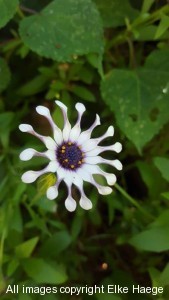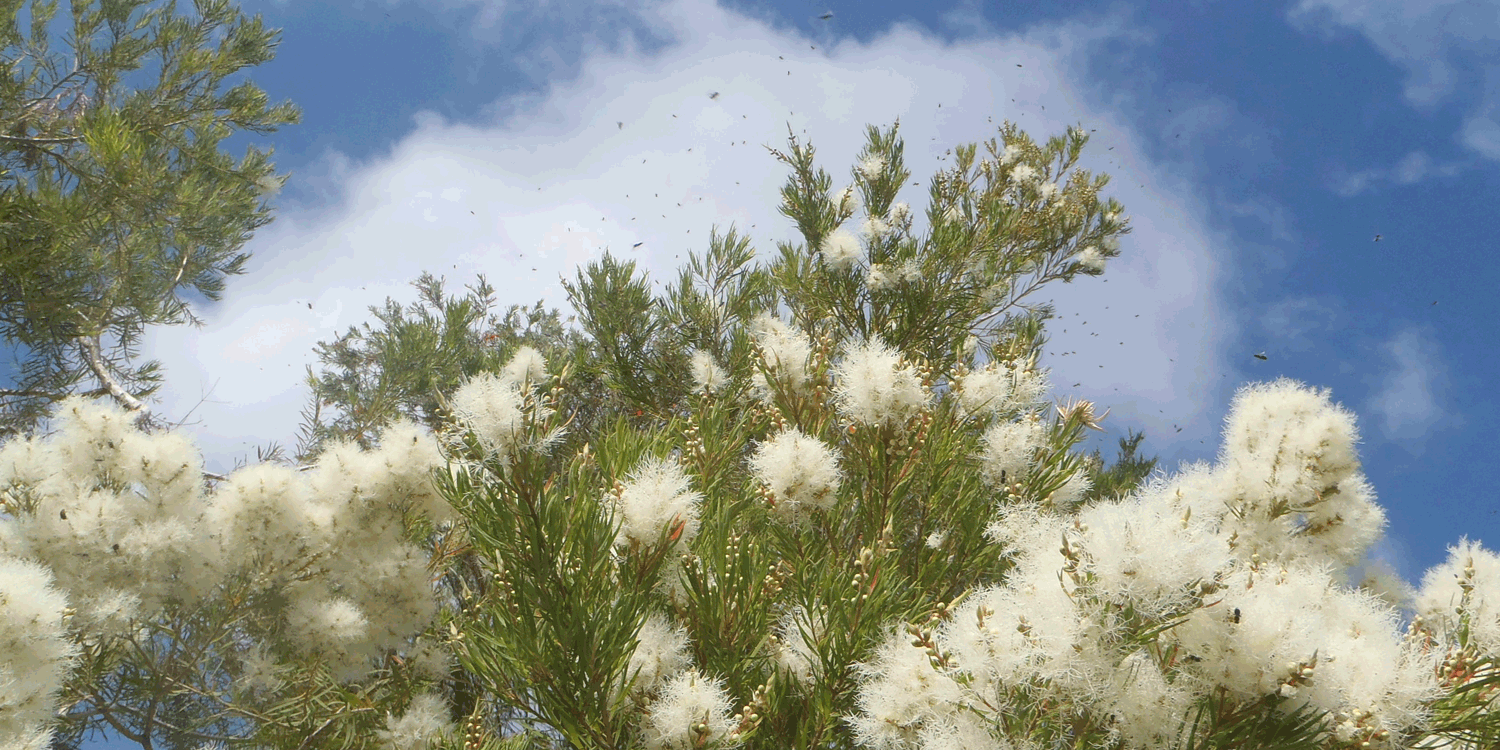
24 Jun Plants (flowers) favoured by Native Stingless Bees – Tetragonula carbonaria in Sydney
Help your local bees. Plant blue flowers. Here is a recent article that Robin Powell, ‘Garden columnist, Sydney Morning Herald’ interviewed me in regard to the last bee season in Sydney. Her article also includes some easy tips for gardeners with a bit of science behind it too.
11.05.20
Some very interesting and relevant information has come out of this recent collaborative research by M. Trinkl, B. Kaluza, H. Wallace, T. Heard, A. Keller and Sara D. Leonhardt in relation to Floral Species favoured by Native Stingless Bees – Tetragonula carbonaria. Here is the link to the full article https://www.mdpi.com/2075-4450/11/2/125/htm
The project was funded by the German Science Foundation (DFG: LE 2750/1-1), the Schimper Stiftung and the German Academic Exchange Agency (DAAD: DAAD PPP Australien).
Of particular interest to the home gardener, looking to plant flowers to support native stingless bees – Tetragonula carbonaria, and relevant to the Sydney coastal basin, here are some planting suggestions based on the research:
Proteaceae species such as:
- Banksia – such as Banksia serrata and integrifolia. There are also great prostrate (low growing cultivars). Try Banksia ‘Birthday Candles’. Hardy, low water and nutrient requirements.
- Macadamia integrifolia/ tetraphylla
- Grevillea – many screen and shrub forms like G. as well as prostrate (low growing cultivars) such as Greveillea ‘Bronze Rambler’.
- Hakea sericea – needlebush
- Isopogon anemonifolius – Drumsticks
- Lambertia formosa
- Persoonia isophylla, lanceolata or levis – Geebung.
- Telopea – the waratah
- Petrophile pulchella – conesticks.
Myrtaceae species such as:
- Eucalyptus – flowering gums (particularly Eucalyptus tereticornis – Forest Red Gum), however,
- other dwarf flowering gums may be more suitable in a small garden/suburban situation and the Angophora’s.
- Melaleuca – such as paperbark, but there are other shrub forms like Melaleuca linarifolia ‘Snow in Summer’ or low shrub: Melaleuca thymifolia (see Pink Lace for example)
- Lilly pillies – such as Syzigium and Acmena – mostly screen shrubs and small tree forms
- Leptospermum species – try Leptospermum rotundifolium, L. polygalifolium – lemon scented tea tree
- Callistemon – the bottle brushes
- Baekea – the heath myrtles – try B. virgata
Asteraceae species such as:
- Daisies – both native species such as Erigeron and seaside daisies, as well as exotic daisy family species such as Osteospermum and Gazania.
Brassicaceae family species such as:
- Rocket/arugala
- Radish
- Let cabbage, cauliflower, broccoli, brussel sprouts, mustard, watercress and bok choy go to flower (for bees to feed on the flower nectar and pollen)
Fabaceae family speices such as:
- Peas (snow pea, runner beans, and sweet peas)
Euphorbiaceae family species such as:
- Poinsettia is a commonly grown and winter flowering plant in the Sydney area
Cyperaceae family such as:
- Carex apressa and Ficinia nodosa (these are sedges/ornamental flowering grasses, often used in raingardens and boggy areas).
This is a very small list of suitable and available plants in the Sydney coastal Basin. There are so many other plants/flowers that native bees will consume.
The 2 keys to try to achieve however, and as noted in the research, is:
- diversity (as it is with us humans – needing a varied diet), and
- to ensure a continuous supply and high quantity of food (i.e. ensure flowers (food) is available throughout all seasons).
Bee Food – ‘Bringing Back the Bees’ with Dr. Katja Hogendoorn. Uni. Adelaide.
07.05.19
Dr Katja Hogendoorn, University of Adelaide and Director of the Australian Entomological Society gave a very interesting talk on the connection of habitat loss and native bees in Australia with RN Radio at this link. Here is a list of 11 bee food native plants that may be suitable in your area. The key message was to increase diversity, but starting with 11 species is certainly going to help.
11 Bee Food Plants – from Dr. Katja Hogendoorn
- Eucalypts
- Hakea
- Grevillea
- Tea Tree
- Wattle
- Boobiala
- Christmas Bush
- Bluebells
- Scaevola
- Goodenia
A short list of plants for native bees in Sydney.
12.02.19
Here is a short list of some useful native plants, noted in this CSIRO Article ‘How to make your garden native bee friendly’, that will attract native bees (both solitary and social). Attracting native bees, you’ll aid the pollination of your other plants and help out by adding some biodiversity into your garden, balcony or verge garden. Eerily enough, there is a lot of crossover with plants that I’ve already listed on earlier posts below and on the main ‘Native Stingless Bees Sydney‘ page:
- Hardenbergia violaceae – happy wanderer. (a sun loving climber that also fixes nitrogen in the soil)
- Leptosperumum sp. – tea tree (this is the Genus from which ‘Manuka’ honey derives)
- Banksia, Callistemon and Melaleuca (species of which contain groundcovers, shrubs and small and large trees)
- Tomato, Chilli and Capsicum (all from the Solanaceae family) and require buzz pollinators, like our Blue Banded Bees and Teddy Bear Bees.
- Macadamia (there are some wonderful dwarf varieties on the market now for smaller gardens).
- Daisies (the short tongued bees and smaller sized bees will be attracted to daisies, both native and exotic).
The article referenced above notes to avoid grasses and non-flowering trees such as conifers
See this lovely short video of a native stingless bee pollinating eggplant (in the Solanaceae family, these flowers, like tomatoes, chili and cucumber) need to be buzz pollinated
What is flowering right now? (in Sydney)
30.01.2019
It has been another HOT summer. The 3rd in a row, hottest on record summer. There has however been a bit of rain too (and it is HUMID). I have seen a number of Magnolia grandiflora about to burst open. I love the scent, and our bees are drawn to it’s pollen rich stamens.
Here is a short ABC article on how to help along our Native bees noting a few plant choices suggested in the article: …recent research already suggests that a range of native insects, including native bees, play an important role in the pollination of crops such as macadamia, blueberry and mango….berries, avocados and nuts…callistemon, brachyscome and melaleuca, perennial basil, salvias and lavenders….Many bees and flies love brassicas (broccoli, kale, mustard)
17th September 2018
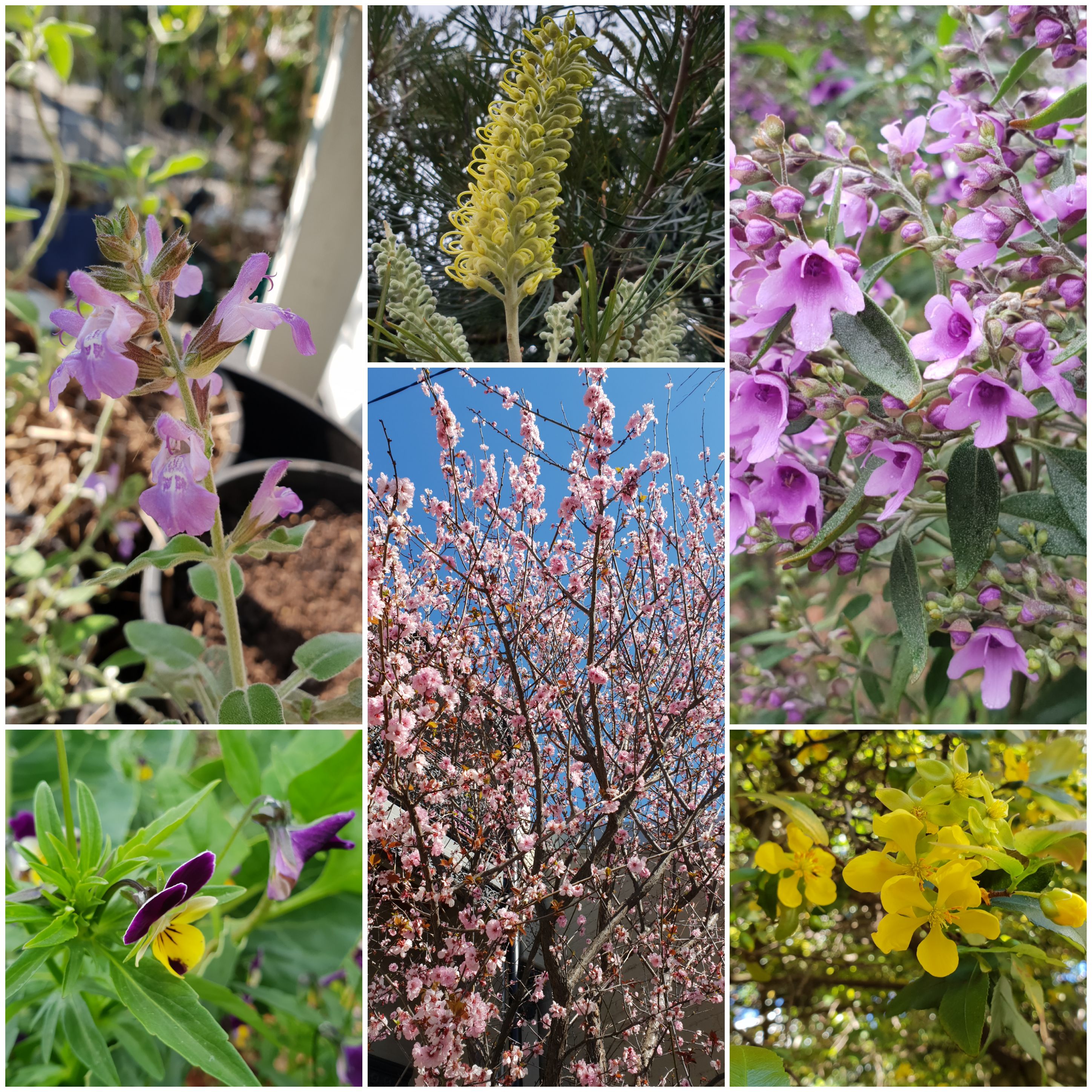
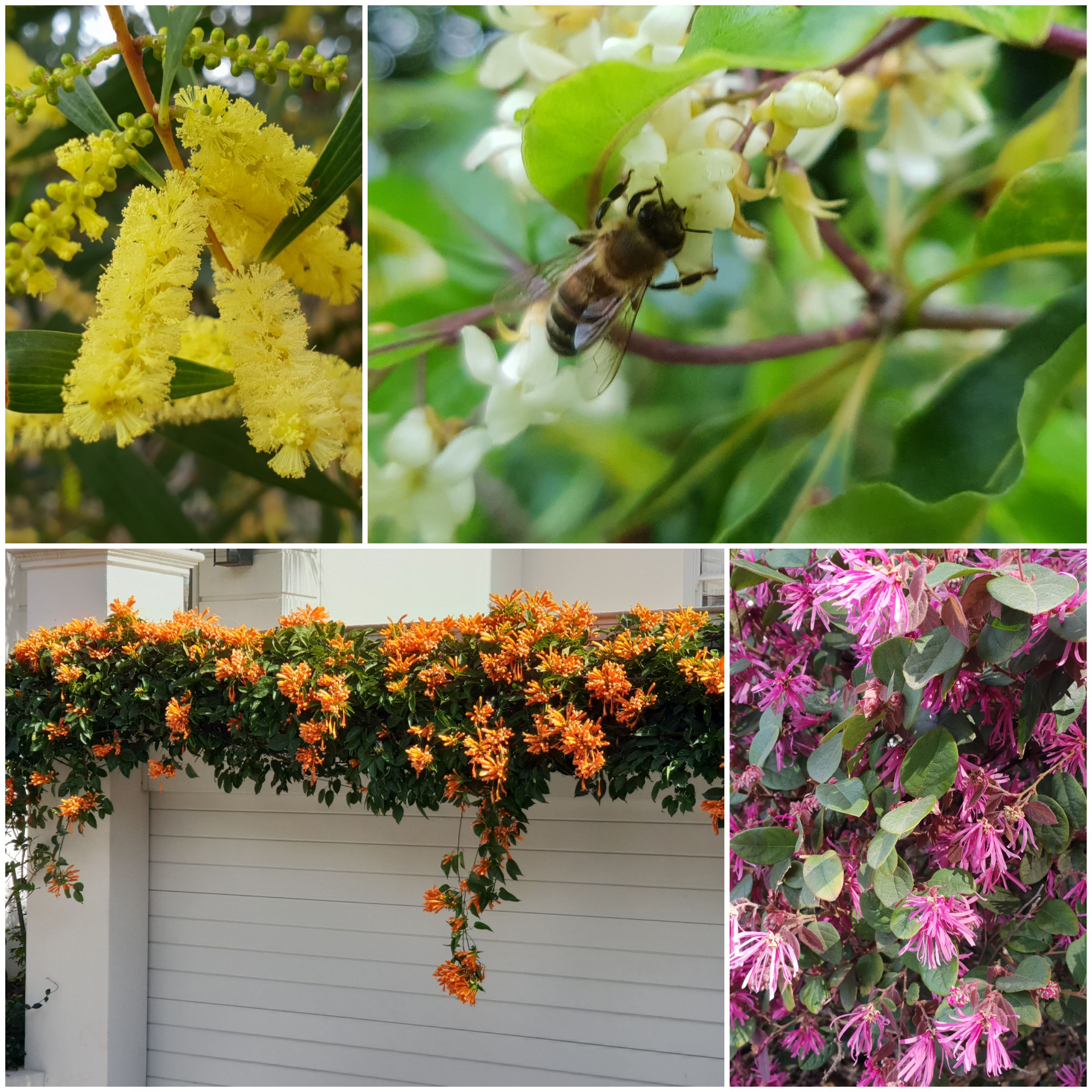
Sydney was off to a slow spring start (following a very cold and dry winter). Here are some of the early spring flowers are blooming in Sydney.
Common sage (it’s been dry clearly), Artemesia, Cherry Blossom trees, Pyrostegia, Loropetalum, Acacia, Pittosporum, beans and peas, rosemary, poppies and arugula, grevillea, prostanthera, Vinca
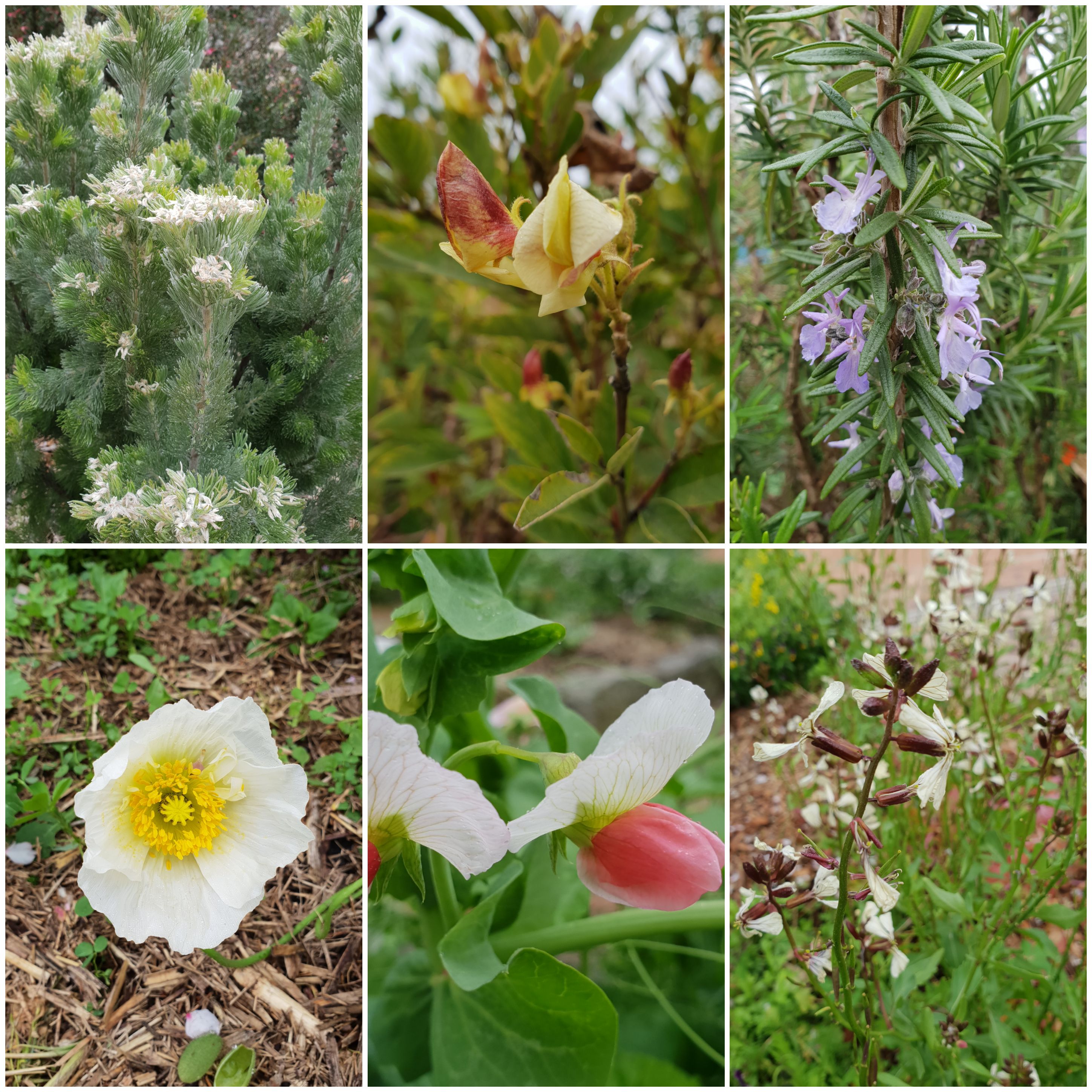
31st March 2017
Have you noticed the deep dark purple tree Tibouchina in flower right now? These beautiful blooms being purple with pronounced anthers do attract native bees. The Tibouchina cultivar ‘Jules’ is a good low shrub with showy flowers.
Autumn generally brings on the flowering of the Paperbark, Melaleuca quinquinerva. And this autumn the paperbarks are certainly providing much needed nectar and pollen to our bees (both honeybees and native bees). The paperbarks are a common street tree, so have a look at the blooms and see if you can see bees having a drink.
Cassia are still flowering, but just about finishing up. You’ll spot Cassia on unkempt roadsides, in bushy parkland reserves and older style gardens. Being attractive to Teddy bear bees, I think we should plant more of these happy yellow bushes.
24th March 2017
Weather (namely lots of rain) has been the main contributor this month to a dearth in the nectar flow. Sydney has seen the wettest March since 30 years. What this means for nectar feeding insects like bees is that they either can’t forage as rain drops can be lethal or that the nectar and pollen in the flowers has washed out (or the flowers have fallen on the ground from the rain) either way, the bees’ precious food source is scarce.
Oddly, I have also noticed things flowering out of sequence. For example: Jacarandas in March! I haven’t seen that before (November is usually their month).
What has started flowering this month are the Paperbark trees. Melaleuca quinquinervia. This tree is an important food source before winter for nectar feeding insects. The bees ripen this nectar at night and it has a pungent, sweet scent a little like fresh uncooked potato that is also sweet.
Camellia buds! – I have noticed many laden camellia buds about to open in a month. Watch this space. Camellia is a winter flowering tree that is an important winter nectar and pollen source for bees.
Hibiscus seem to still be flowering, but I wonder about the amount of pollen or nectar in their flowers.
Cassia (or senna) is an important flowering shrub for solitary bees, particularly the teddy bear bee. Cassia is in full flower currently right accross Sydney.
Schefflera – The umbrellla tree. Considered a weed (and exempt in most councils for requiring permission to be removed), the Schefflera has been producing long lasting flower spikes lately. These flower spikes produce sweet, sticky nectar for bees and insects.
_________________________________________________________________________________________________
Honeybees: Here is a scientifically based article on what to plant for honeybees (UK based plants). Most information on the internet is not scientifically grounded in the types of flowers/plants/trees recommended to be good for bees, which is why I thought I’d point this article out. Interestingly, the researchers found that, of the 437 different types of plants in flower in April and May in the Wales Botanic Garden where the study was conducted, only 11% were used by bees.
The plants listed may not be suitable in your part of Australia, nor might you be wanting to attract honeybees over native bees, however listed are: Peonies, wallflowers, roses, and hyacinth, gorse, willow, hawthorn, oak and dandelion, apple and cherry trees, hellebore’s, oak, and holly.
__________________________________________________________________________________________________
15th February 2017
What a hot 2 months it has been! This heat is affecting what plants and trees are in flower. As of yesterday, the paperbarks have started to come into full bloom. In flower and of note now are:
- Melaleuca quinquinervia – Paperbark trees. Traditionally in Sydney this is a late summer – autumn flowering tree which provides a very good staple diet for both native bees and honeybees.
- Buckinghamia celsissima – Ivory Curl Tree (a great small tree and hardy street tree, originating from Northern Qld). Take a close look at the blooms and you’ll find a diverse ecosystem of happy, hungry insects (and native bees).
- Lagerstroemia indica – Crepe Myrtle (an exotic tree, but extremely drought hardy). The crepe myrtles and the bees have been enjoying the extended flowering period of this tree this year.
- Plumbago – potato vine. (not of use for pollinators unforunately)
- Grevillea. Numerous varieties, but in flower now is a pale yellow form. Attractive to birds and insects (including bees) for its nectar.
- Scaevola is still flowering which is great.
- Borage is also flowering now. A flower that needs buzz pollination which can be performed by some of our bees.
_________________________________________________________________________________________________
1st February 2017
In flower now is:
- Abelia (a favourite for our blue banded bees and teddy bear bees)
- Hibiscus – favoured for its pollen by a variety of native bees and honeybees.
- Frangipani (not of use unfortunately for bees from a pollination perspective)
- Oleander have a long flowering period. It is not known if oleander is beneficial for bees.
- Lagerstroemia – crepe myrtle (a long flowering period exists with these african species)
- Lavender (we are seeing the end of lavender for most varieties)
- Callistemon – Bottle Brush (unusually – as their time for flowering is October)
- Very early signs of the Paperbarks flowering
- Basil (try some perennial basil – and /or let your basil plant go to flower and watch the bees create you seed for next year)
- Geranium
- Roses
- Salvia (purple are favoured by the bees)
- Marigolds (a good beneficial companion plant as well as provider of pollen – the single varieties only, not the double varieties with billowy petals that hide the pollen)
- Vinca – tough, hardy and loves poor growing conditions. (not necessarily a staple for pollinators)
- some citrus (again for the 2nd time this spring/summer)
- begonia – (small amount of pollen available)
- zinnia – long flowering and a good pollen source.
______________________________________________________________________________________
23rd January 2017
Following a few weeks with very hot temperatures (heat wave conditions) and minimal rain, there is not the abundance of flowering plants we had around Christmas time. In full flower now is:
- Buckinghamia celsissima – Ivory Curl Tree (a great small tree and hardy street tree, originating from Northern Qld)
- Lagerstroemia indica – Crepe Myrtle (an exotic tree, but extremely drought hardy)
- Scaevola aemula – Fairy Fan flower (a very bee attractive groundcover for full sun, has a long flowering period and is very hardy)
- Lavender (all types). Honeybee and other native solitary bees are really enjoying lavender at the moment.
- I’ve noticed a second flowering of some citrus (lemon, lime, orange)
- Verbena is also in flower and attractive to some of the smaller bees like our stingless bees, Tetragonula as well as other small native solitary bees like Homalictus and Exonuera.
- Vinca or periwinkle is in flower right now and can be seen growing on street verges and other really hot and dry locations. It thrives on having little to no attention.
My perennial basil has been so popular for months now with an assortment of bees and my perennial basil bush appears to have been adopted by a family of blue banded bees (there are about 6 of them buzzing around and foraging the flowers all day, every day). One thing cuter than a blue banded bee is a baby blue banded bee!
___________________________________________________________________________________
3rd January 2017
- Still in flower since late November are the Magnoilas and I even saw a few of the last Jacaranda flowers yesterday (however I would consider Jacaranda’s flowering period is over till next November).
- Ceratopetalum – NSW Christmas Bush is in flower as are the Frangipani trees (although I don’t believe Frangipani’s are attractive for pollinators including bees).
- Perennial basil keeps setting blooms and attracting many kinds of bees and
- the flowering salvia are well in their blooming season.
- The dwarf eucalypts are looking spectacular in flower right now and are a great bee attracting plant. This is a great small tree for a courtgarden, large pot or as a street tree under powerlines.
- Lemon myrtle – Backhousia citriodora is in full bloom and very attractive to bees right now.
- It is the beginning of the Ivory Curl Flower – Buckinghamiana celsissima flowering period too.
_____________________________________________________________________________________
21st December 2016. (Summer)
- Following a decent amount of rain and some warm and very warm days, the trees and plants have started to respond and I am noticing a few trees that have flowered early like the Crepe Myrtle – Lagerstroemia indica (these were in flower last season in March)!
- Magnolia’s (pictured right) are still flowering and have had a long blooming period this season. They are just about to finish flowering, so enjoy the refreshing scent whilst you can.
- Jacaranda’s had an incredibly long flowering period and I would now say they have finished (with the odd exception on a few protected trees).
- Gardenia flowers are smelling and blooming well
- Hibiscus trees
- The Illawarra flame tree with its brilliant red sepals (and bare of leaves at this time) is bright and brilliant. (although more dramatic when they flower in sync with the Jacaranda).
- Corymbia sp (pictured right). and Angophora sp. trees are displaying creamy blooms right now, as is Eucalyptus ficifolia (pictured right – red flower). And these three species are supplying the native stingless bees very well. Also an attractant to our native bees is:

- Water Gum, Tristaniopsis laurina flowering very well this year and attracting many different species of native solitary bees
- The Brush Box, Lophostemon confertus street trees in my area this year flowered just before a very hot day followed by heavy rain, so the blooms were mostly destroyed and not producing nectar, however there are a few late blooming inflorescence’s on those trees that are in tact and nectar laden. The honey bees are attracted to the brush box as well as some of our native bees. The honey is pale, distinct in flavour and produces much nectar for the honey bees to store.
- Pepper trees are starting to bloom. It might seem that pepper tree flowers are attractive to bees, but I have seen pepper trees buzzing with bee activity; mainly honey bees.

- Now for the smaller plants, edibles and herbs: Thyme, perennial basil (still), verbena, nasturtium (still), oregano and marjoram
- Backhousia citriodora (the leaves are great as a tea) is in flower now and being enjoyed by many an insect and bee.
- Correa, spider grevillea, banksias.
- and finally, the Mandevilla vines are going very well at the moment in bloom.
____________________________________________________________________
1st December 2016. (Summer)
- The Jacaranda trees’s have had a long season this year and some are still in flower over 5 weeks later in the first week of December. Purple is a farourite colour amongst bees (I did see a white Jararanda in flower in Cremorne last week).
- The Magnolia trees started in mid November and are in their last two weeks of blooming (in my area).
- Angophora costata, floribunda and Corymbia trees are displaying their fluffy creamy white inflorescences and attracting a plethora of bees, insects, beetles and other pollinators. They look spectacular as street trees.
- Melaleuca thymifolia and alternifolia are flowering too. Just look at this amazing photo below I took of the bees having a frenzy on the blooms. The sky is almost thick with their little silhouettes!
 Enjoy your Summer. Let me know what is flowering in your area and if you see bees on a particular flower so we can share the information around.
Enjoy your Summer. Let me know what is flowering in your area and if you see bees on a particular flower so we can share the information around.
__________________________________________________________
Spring (Late October 2016). Every time I look at the moment, yet another plant or tree is in bloom. Here are some late October additions to the ‘ What’s Flowering ‘ list:
- The onion family are starting. Think garlic, spring onion, leek. (last photo in the row below)
- Hibbetia is still flowering along with the nasturtiums and the odd salvia (1st photo)
- Nandina domestica is proving a good, hardy semi shade tolerant plant that is attractive for its nectar and pollen (3rd photo)
- Perennial basil is just powering on and will always bee hard to prune as it is always in flower (4th photo)
- Dianella caerulea is in flower now and a good plant for spying the peacock carpenter bee Xylocopa bombylans (5th photo)
- Flat leaf parsley left to go to flower is useful for the smaller bees including Tetragonula and Homalictus (6th photo)
- Star jasmine is in flower, but I have never seen bee activity on it. Some scents just don’t attract. (7th photo)
- Passionfruit is in flower and some have started to set fruit.
- Dichondra repens with its hirsute covering and minuscule silvery green flowers is in flower.








___________________________________________________________________________
Spring (October 2016). We are having a true spring, possibly a bit early, but certainly not 2 months late like last year. It feels like all the plants are in full production mode and it is a delight to smell and see. What I am noticing in flower at the moment is:
- Robinia pseudoacacia – Golden Robinia with their white inflorescence’s with a small dusty pink base. If you get a chance to smell one – do.
- Flindersia australis – the trees with the starry shaped cones that people collect at Christmas time. These waxy small white flowers form in clusters on the tips of this versatile and hardy street tree.
- Callistemon viminalis – October signals the blooming of the Red Bottlebrush and the bees have been working the pollen and nectar on this tree all October.
- Jacaranda trees! it is too early for Jacaranda’s, and I’ve only seen a tinge of purple, but they’ll soon be out marking the beginning of November.
- Lavender galore
- Holm oaks are in bud
- Macadamia are finishing and Avocado trees starting.
- Citrus is still in flower and already setting fruit.
- Bouganvillea is brightening up fences and walls in all their various colour schemes.
- The Turpentine trees – Syncarpia glomulifera with their creamy pom pom stamens are standing out and attracting the pollinators
- Some Eucalyptus species: Spotted gums, Tallowwoods and Lemon scented Gum trees have just started blooming with their creamy yellow flowers. These are pollinator magnets and don’t flower every year.
- Nasturtiums are continuing since last month
- The Nandina domestica bushes – sacred bamboo also have their flower spikes out. I used not to be a fan of this bush till I saw blue banded bees on it near my office in Kings Cross.
So these are just a few October flowering plants that I’ve noticed in my area. How about you? What is flowering in your garden
________________________________________________________________________________________________________
Spring (September 2016). We are now in Spring and it has been a wonderful start to it from a bee’s point of view. The weather has been relatively stable (last spring we had 2 and a half weeks of constant rain and cold temps followed by low temperatures that set the bees back almost 2 months). There is also a lot more flowering now than this time last year.
What “springs” to mind is:
- the fragrant jasmine which was out very early this year (at the end of August).
- The salvia’s flowered right through winter for me, as did the ever reliable perennial basil. The Eucalyptus microcorys in the Eastern Suburbs has been in flower during the later part of winter.
- I’ve just noticed the Callistemon viminalis (red bottlebrush) just starting which is a week or so early. Usually mid October flowering.
- I saw my first passionfruit bud on my vine too (which is a little early) although I suspect this might fall off with the cold snap we are having right now.
- This spring was SPECTACULAR for the bronze Pandorea pandoreana Ruby Belle climber and at a client’s place in Northmead, the Tetragonula carbonaria were going crazy for it.
- My citrus has had flowers since the end of August and is now in full flower – like most of my client’s citrus across Sydney.
- I tihnk it will be a good season for lavender as well with the warmer and drier start to spring. Some lavenders I observed in full flower through winter.
- the Prostanthera – mint bushes are mostly finished now, but had a good flush at the beginning of spring.
- Carpobrotus – pigface was in good flower at the end of winter this year.
- Hibbertia scandens – Guinea flower started in September and is continuing to the end of September.
- The cherry and almond blossom is now just about finished, but they had a spectacular display right on time through September (mainly in the northern suburbs).
- The daisy’s (ASTERACEAE) are all in good bloom right now too.
- Dianella caerulea is also just out (end of September) which is a bit early – but the Blue banded and Peacock Carpenter bees will be happy about that!
So that is about it for beneficial flowers (off the top of my head). What is flowering around your place at the moment? (updated 29.09.16)
______________________________________________________________________________________________________________
Autumn (2016) has been a very unusual one in terms of weather.
March/April has simply been FANTASTIC for the bees in the coastal and eastern areas of Sydney where I keep stingless bees. The reason being that there is so much in flower right now (but it shouldn’t be).
February was really hot (comparatively) and January was wet. Spring 2015 was about 1.5 months late (perhaps this warm April is making up for that). This means that for me, the honeybee season has been about 2 to 2.5 months late and a poor one due to the unpredictable weather. This also means that I’ve enjoyed the odd passionfruit (a favourite of the stingless bees) both in late December and again in April (that is almost unheard of!) I suspect the last green fruit left on the tree wont mature, but that is what I thought of the fruit I’ve just harvested. Having said that, the crop hasn’t been very good.
The other thing I’ve noticed that is particularly unusual, is that the flowering salvia have been trying to grow and flower, but haven’t been able to till now (April). This is unusual in my area. Last year they flowered from December through to February.
In March/April 2016 we’ve experienced stable and warm autumn temperatures which have somewhat confused the flowering plants.
The bees are driven by the temperature, seasons and sun as it affects what plants are flowering – and hence their food source.


- In the last week the Melaleuca quinquinervia – Paperbarks have all seemed to bloom at once. This is a particular favourite for honeybees at this time of the year (the stingless bees love the paperbark nectar too). The heady scent reminds me of raw potato that has just been cut.
- also in flower just now are the Camellia sasanqua (normally a winter flower)
- The Magnolia grandiflora (and their dwarf cultivars) had a 2nd blooming event in mid March (the stingless bees love their pollen).
- The flowering salvia’s are out in force right now. (also a favourite of blue banded bees and stingless bees).
- Lagerstroemia – crepe myrtle seemed to keep the bees (stingless and honey) going in the dearth of February when not much else was flowering.
- Tibouchina followed the Lagerstroemia in March/early April.
- Lemon verbena flowered in late feb/early march this year.
- French tarragon is in flower in April (normally January).
- also flowering in January were the saucer Magnolia – Magnolia soulangeana (a second blooming for this species as well)
- speaking of multiple blooming periods, the Syzigium have enjoyed numerous flowering periods (and are still in flower in April)
- Lophostemon confertus – Brush box are enjoying april blooming (although they also had a small flowering period in Feb). This is an important nectar source tree.
- Eucalyptus paniculata are in flower in April too indicating favourable flowering period right now.
- also in flower now are some of the Banksia serrata (a good native bee attractant).
- Baekea and Leptospermum were great in February.
- Perennial basil has done really well from Feb – April (and I suspect will continue for a few more months).
- Westringea (coastal rosemary) is beginning to flower, but the Rosmarinus officionalis seems to be holding out this year with no flowers to report as yet.
- Chilli plants are continuing to flower throughout the whole summer/spring/autumn season whereas the tomatoes didn’t do well in my area due to the January rains.
- Gordonia axillaris are flowering in the northern suburbs (again a late autumn/early winter flower).
- Hibiscus are looking splendid at the moment (they don’t have much nectar, but do have some pollen that the bees will go for if other pollen is not readily available)
- Buddleja has been in flower the whole way through from spring to April (although it is not in its full glory right now, it is a good pollinator – for hover flies amongst other pollinators).
- Also of note were the Dianella caerulea in spring time (October) this year. ( a great favourite of the Peacock carpenter bee).
There are so many more flowering plants this April 2016, they are too many to list here (and may be very different in your area). For me, this is an exciting late part of the bee-keeping season as well as a very interesting observation of climate change and the effect it is having on the bees and other pollinating insects and animals, which in turn is effecting the ecosystem equilibrium.
Being a landscape architect, arborist and beekeeper, it is a most fascinating area of research for me.
What is flowering in your area? I’d love to hear from you. send me an email: elke@elkeh.com.au or post on my facebook page.
I am currently working with a very talented scientist and beekeeper to work out exactly what flowers and plants the stingless bees prefer so that we can provide you with a definitive list of pollinator plants for the Tetragonula carbonaria – Australian stingless bee.
If you would like to use any of this information, please send me an email or contact me for written permission.

